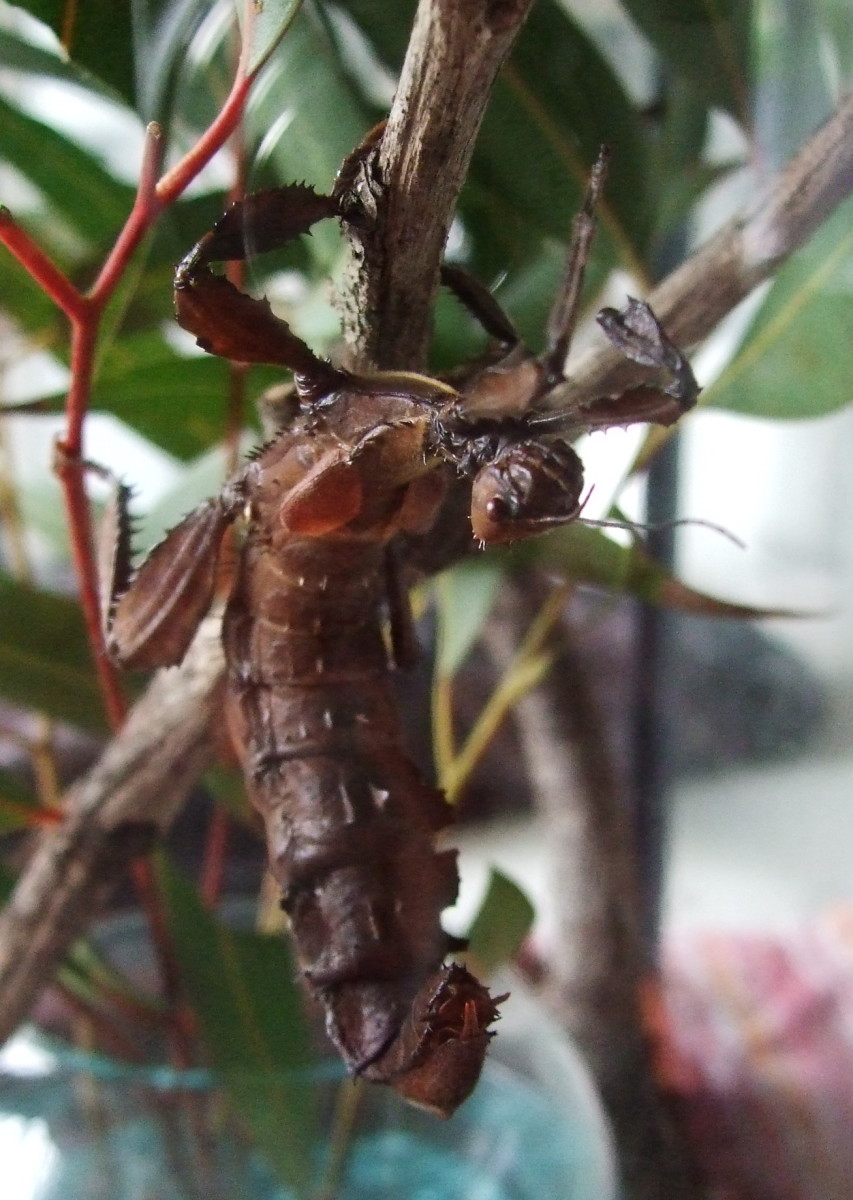How to design your really weird alien

Use insects as inspiration for your bizarre alien.
As a writer of science fiction or fantasy you may need to design bizarre-looking aliens for your story and a world for them to live in. In this page you will find inspiration for truly weird aliens, by watching the aliens that live right under our noses: the insects.
Insects are amazingly weird. Compared to our bodies, theirs are inside-out as well as upside-down. They breathe through tiny tubes all over their bodies. They smell with antennae. Some taste their food with their feet. Many insects are deaf, but those that are not, hear with their front legs or antennae. They have no voice, yet some make noises. They see with large, compound eyes.
Near the end of this page, you'll find two useful books on world building for science fiction writers.
Inside-out
Insect bodies are inside-out, because their skeletons are not inside their bodies, but on the outside. In fact, an insect carries its skeleton as a kind of harness. Similar to the harness of a Knight from the Middle Ages, the insect harness has hard, stiff parts where the body needs to be well protected, and softer, more flexible parts near the joints.
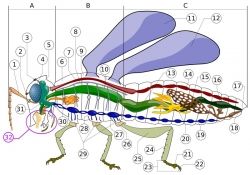
Upside-down
If we go on all fours, like an insect, then our back is above and our belly below. On top of your back you can feel your spine, through which runs the nerve cord. Your heart and the most important blood vessel, the aorta, lie below the spine. At the bottom is the alimentary canal: your gullet, stomach and intestines.
Compared to ours, the insect body is upside-down: the nerve cord runs along the lower side of the body and the heart and aorta are on top. The alimentary canal is therefore situated in the centre of the body.
Moreover, the insect heart is at the back of the body, instead of near the front as in our bodies (if we stand on all fours). In an insect there is only one blood vessel (few exceptions occur), which runs along the midline of the back. The heart is the back end of the vessel and has a series of valved openings through which the blood can enter. The blood is pushed forward by contractions. To the front, the vessel, or 'aorta', is a uniform contractile tube. It ends abruptly after passing through the brain and the blood simply percolates backwards through the tissues, to enter the heart once again.
Respiration
Insects have no lungs, but they breathe through thin tubes which open along the sides of the body. These tubes, or tracheoles, branch and become finer and finer, until they form a network around or inside tissues or muscles. This allows them to bring oxygen direct to those parts of the body that need it. Carbon dioxide diffuses through the skin and out of the body. Insects do not breathe out, therefore, as we do.
Feeding
Insects have three pairs of mouthparts. The first pair serves to crush, like our teeth, the second to grasp, like tongs, the third to taste and probe, like our tongue. In most insects, one or two of the pairs of mouthparts have been modified for specialised eating techniques. A few examples:
- In lacewing larvae, the first pair of mouthparts has become pincer-shaped to grasp their prey.
- In butterflies, the second pair fused into a long 'drinking straw'
- In some weevils, all three pairs fused together to form a powerful drill at the end of their long snout.
The senses
Each creature needs senses to perceive its surroundings. Like us, most insects have five senses: they can feel, see, hear, smell and taste.
Feeling
Insects ‘feel’ with hairs on their bodies. Almost all hairs are connected to sense cells which are stimulated when the hairs move. Those sense cells are usually most abundant on the antennae, which are thus important tactile organs, but the cells occur all over the body. Insects can, therefore, feel with all parts of their body. In that sense they are not unlike us.
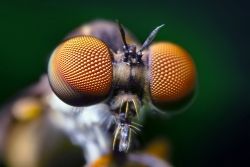
Seeing
Some insect eyes can be nothing more than small groups of light-sensitive cells beneath lens-like thickenings of the skin. This kind of eyes are called 'simple eyes'. The simple eyes cannot perceive imagines; they only allow insects to respond to light and darkness or to perceive the movement of prey within the field of view.
Other insects have highly developed compound eyes. Compound eyes are groups of facet eyes in which each has its own lens. These eyes are, just like our own eyes, able to perceive images and the insect can accurately judge the distance of an object as it has also a form of binocular vision. The images they see are, however, far less defined as those that we see. What insects perceive is more or less what we see when watching a newspaper photograph through a magnifier: a picture composed of dots.
Insects have colour vision, but they perceive colours differently from us. For example, bees are blind to red, but can see far into ultra-violet, something we cannot. Indeed, it has been discovered that many flowers that we perceive as 'white' have various colours to insects.
Compound eyes can do something our eyes cannot: they can perceive polarised light. Light coming from a blue sky shows a characteristic pattern of polarisation that is related to the position of the sun, and insects are able to orientate themselves by means of this pattern.
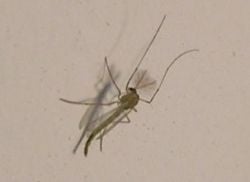
Hearing
Many insects are deaf and those insects that are able to hear, have no ears. Most insects, therefore, hear in a way different from ours. Those insects that do have ears belong the locusts, grasshoppers, butterflies and moths. Their ears are not on their heads, but on their belly, thorax or front legs. Their highly developed hearing organs are made up of groups of cells that are stimulated by the movements of a membranous ear-drum. These insects can hear sounds with much higher frequencies than we can.
Male mosquitoes hear with their antennae. High-pitched sounds emitted by females in flight set a male's antennae in vibration, and this vibration is picked up by sensitive sense organs.
Again other insects hear with bristly hairs that are set in vibration by sound waves.
Smelling
Insects smell, i.e. detect odours, mainly through their antennae but also, to a lesser degree, through the palps (appendages of the mouthparts). Smell can be used to find food, the right plant on which to lay eggs, the right larva in which to lay eggs, and mates. Some male moths are able to detect and locate a female by smell from a distance of one to two kilometres!
Tasting
We humans taste flavours with our tongue. Insects taste in different and varied ways:
- Bees, wasps and ants taste with their antennae
- Beetles taste with their palps
- Flies, butterflies, moths taste with their feet
- Honeybees taste with their mouths
- Plant- and blood-sucking insects taste with the throats
Communicating
We communicate with language, be it spoken or written, but we also use body language.
As insects have no voice, they use their own ways to communicate. They use chemical substances, called pheromones. These pheromones are smelled or tasted by others of their species, and cause a reaction in the recipient. Pheromones and are used for various reasons:
- Ants use them to lay down trails towards a food source
- Migratory locusts use pheromones to form swarms
- Many insects use pheromones to attract mates
Making noises
Although insects cannot speak, bark or peep, some are able to make noises:
Crickets rub front wings against each other.
Grasshoppers make sounds by stridulation, i.e. by rubbing the hind leg against the front wing.
Cicadas make their distinct noise again in a different way.
They posses a kind of internal drum. The membrane of this drum is a stiff cuticle that is made vibrating by fibrillar muscles that contract several hundred times per second.
Surviving freezing winters and dry, hot summers
We humans have little to fear from cold winters or hot summers. As long as we have enough to eat and drink, we have enough energy to keep our body temperature at the right level. For coldblooded animals, like insects – and maybe your alien – the situation is different. Their body temperature depends on the surrounding temperature. When that becomes too low, they can freeze to death. Alternatively, great heat can dry them out. Luckily, insects have found a way to survive these difficult circumstances.
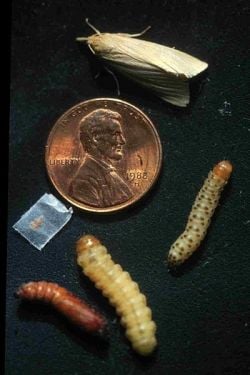
Diapausing
Many insects, particularly in the temperate zones, spend the winter (overwinter) in a state of diapause, during which growth and development are temporarily arrested. In this state, they are often resistant to temperatures well below the point of freezing. They make preparations well in advance: already in late summer (often early September) they store certain fatty substances in their bodies that will work as antifreeze. When enough fats are stored, they stop eating and search for a hiding place to spend the winter.
On the photo on the right you see all of the life stages of the southwestern corn borer (Diatraea grandiosella). Clockwise starting at top: adult moth, non-diapausing (spotted) last instar larva, diapausing (immaculate) larva, pupa, eggs (laid on wax paper), first instar larva (above date on coin).
In areas where summers are hot and dry, and therefore dangerous for insects - they can easily dry out - they oversummer in a state of summer-diapause, which resembles winter-diapause in that again growth and development are in temporary arrest.
Both winter- and summer-diapause are not easily broken. A change in day length (lengthening in the case of winter-diapause; shortening in the case of summer-diapause) followed by increasing (winter-diapause) or decreasing (summer diapause) temperatures are usually required to 'wake up' the insects from the diapause state.
All of the life stages of the southwestern corn borer (Diatraea grandiosella). Clockwise starting at top: adult moth, non-diapausing (spotted) last instar larva, diapausing (immaculate) larva, pupa, eggs (laid on wax paper), first instar larva (above date on coin).
Further reading
- The Earth Life Web, Insect Morphology and Anatomy
An introduction to the form and function of the insect body - Insect Mouth Parts
Examples of different kinds of insect mouth parts - Insect_Vision
Insect Vision The pictures above illustrate three basic models of the compound eye. Adult insects have one pair of compound eyes. As the name suggests, the compound eye is made up of a series of 'eyes' compounded together - that is they have many le - Diapause - Wikipedia, the free encyclopedia
Diapause is the delay in development in response to regularly and recurring periods of adverse environmental conditions.
What will your alien look like?
Two important problems occur when you choose an insect as your alien and simply 'blow it up' to a monster as big, or bigger, than a human being:
Problem 1
Its external skeleton, or harness, will not be strong enough for such a size, and your alien will collapse under its own weight.
There are a few solutions for this problem:
- The alien's home planet is smaller than Earth and has therefore a much lower gravity. This would cause the alien to weigh far less.
- Your alien's 'harness' could be made relatively thicker and stronger.
- Your alien lives in the water.
Problem 2
You should also be careful about how your alien breathes. Oxygen diffuses only slowly through the tracheoles; in a man-sized insect, the organs and muscles will receive oxygen so slowly, that our poor alien, if it does not suffocate, will be extremely sluggish. You can solve this problem in the following ways:
- You could make the alien very thin, e.g. two metres high and one centimetre in diameter. (I don't know if such a creature can walk upright, though!)
- You could give the alien lungs or gills to breathe with, or give the tracheoles built-in pumps to make the oxygen move faster.
A last thought
What would you think of a creature that is a peaceful vegetarian in spring and summer, but turns into a fierce predator because it needs animal fats for overwintering to come through the severe winter of its planet?
Do you believe aliens exist?
Do you believe that somewhere on a planet in the universe there are aliens about?



